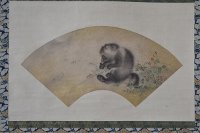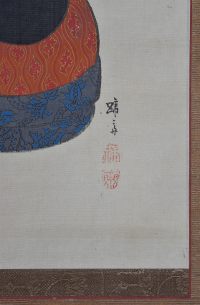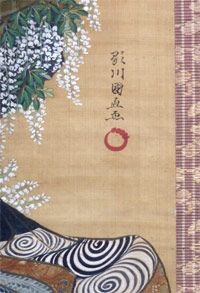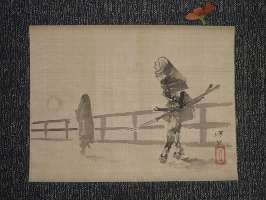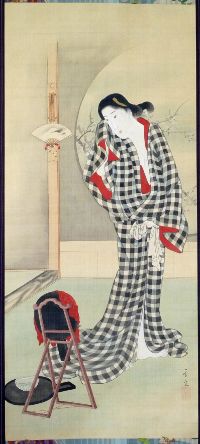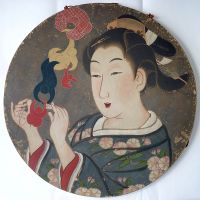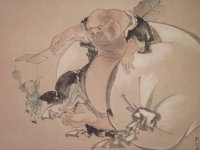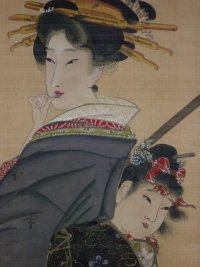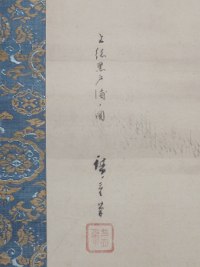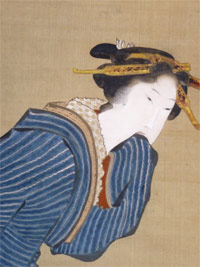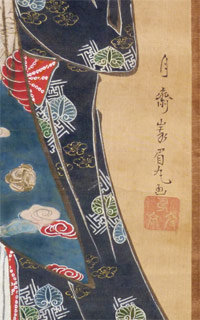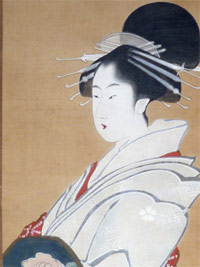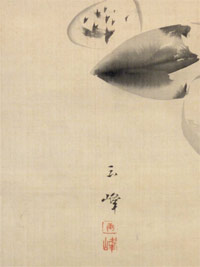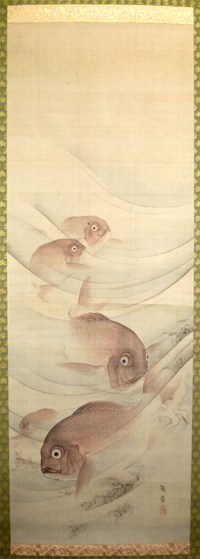/category/paintings/page/4/
KAIGETSUDO School

Click here to view image full size.
An original painting, full colour on paper, 39.75 x 15.25 in; 101 x 38.75 cms. Shows a beauty erotically biting a cloth. The kimono is decorated with a strong motif of flowering plants. The school was founded by Kaigetsudo Ando (1671-1743). He had a tight-knit atelier of artists who followed his style of large single standing beauties with bold drapery and small faces. There are many copies of the leading Kaigetsudo artists and it’s refreshing to have an unquestionably authentic painting of the period, c early 1710s. Minor imperfections but all in line with the age of the painting, otherwise good condition.
Status: Sold

Click here to view image full size.
Torii KOTONDO (1900-1976)

Click here to view image full size.
An original painting, full colour on silk with touches of gold, 45.5 x 14.5 in; 115.5 x 36.75 cms. Shows the famous story of the demon Ibaraki of Rashomon (a gate south of the Imperial Palace in Kyoto). The tale relates how Watanabe no Tsuna cuts off the arm of the demon Ibaraki near the Rashomon Gate in 976 to free the neighbourhood of the beast. Watanabe locks the arm in a box. Subsequently he is visited by his wet nurse who asks to see the arm, whereupon she seizes it and flies off revealing her true guise as that of the demon. The story was made into a No play, Ibaraki, and later a Kabuki play. Kotondo is famous for his beauty prints of the late 1920s and early 1930s. In fine condition. Signed Kotondo ga with Kotondo seal.
Status: Sold
Ichiryusai HIROSHIGE (1797-1858)
Click here to view image full size.
A fine original painting by Hiroshige I, sumi on silk, image size 38 x 12.5 in; 96.5 x 31.75 cms. Shows an avenue of trees leading to a small bridge beneath a torii; bands of mist, and, in the distance, another torii and a lake or open sea with sails. A beautiful composition. I have not been able to identify the location: It was not unknown for Hiroshige to paint imaginary landscapes or use poetic license.
Signed Hiroshige ga with Ichiryusai seal. In very good condition having been recently remounted.
Status: Sold
Mori SOSEN (1747-1821)

Click here to view image full size.
A fine original painting, sumi and light colour on silk; 41.75 x 15 in; 106 x 38.1 cms. His life is not well documented but he is known to have studied under the Kano artist Yamamoto Joshunsai (? -1781) before being drawn into Maruyama Okyo’s (1733-1795) artistic circle and his style is more Shijo than anything else. His animal paintings were evidently highly valued by Okyo. He was an immediate favourite with eastern collectors because of his monkey paintings at which he excelled, although he was more versatile than literature implies and highly accomplished at drawing other animals. But his images of monkeys take precedence and he is considered the pre-eminent painter, east or west, on this subject. He is said to have lived in the woods for three years eating fruit and nuts to better study the monkeys and other animals at close quarters. (Even if this is apocryphal it underlines the appreciation of his commitment to understanding the monkey.) Shows two monkeys on a bough beneath a large red sun. In very good condition. Genuine Sosens (and there are many copies) show a great skill in the way their fur coats are built up with hundreds of fine strokes. The box that goes with the painting has an inscription on the lid: “A painting of monkeys by Mori Sosen” and on the underside of the lid is a guarantee by Ayaoka Yushin (a Shijo painter and pupil of Shibata Zeshin, [1846-1910]) signed Ayaoka with seal Yutoku and dated June 1891. The painting signed “Painted by Mori Sosen early spring [=January] 1800” with seals Mori Shusho and Sosen.
Status: Sold
Mori SOSEN (1747-1821)
Click here to view image full size.
An original fan painting of a baby tanuki amongst autumn grasses and beneath a full moon. Sosen was a close observer of nature (even, it is said, living for a while in the woods to closely observe the animals). He is best known for his monkey paintings, of which there are many copies. The tanuki, or Japanese raccoon dog, is frequently depicted in Japanese art and mentioned in the folklore. It was reputed to be a mischievous creature and a master of disguise. Sumi and colour on a gold-flecked paper ground; 8 x 20.5 in; 20.5 x 52 cms. Mounted as a scroll. Old mount and box. An inscription on the inside of the box reads: Kokou Souryo shintei, “Judged by Kokou Souryo.” On the outside the inscription reads: Shunsou-tanuki-senmen, “Autumn grass tanuki fan.”
Sosen hitsu. Painted c. 1800. Signed Sosen with seals Shusho. Good overall condition.
Status: Sold
Hishikawa MOROSHIGE (Fl. 1684-1704)
Click here to view image full size.
An original painting showing a go game being watched by beautifully attired ladies. Moroshige was the senior pupil of Hishikawa Moronobu, and, it is said, was the father of Furuyama Moromasa. Sumi and full colour with extensive gold on silk; 10.75 x 15 in; 27.5 x 38 cms. Newly remounted with futomaki and box. Provenance: Ex William Sturgis Bigelow collection. He was one of the first Americans to live in Japan and much of his extensive collection went to the Museum of Fine Arts, Boston. His original seal has been affixed to the side of the box.
Painted c. 1700. In very good condition. Rare: A fine painting and nice subject.
Status: Sold
Nagasawa ROSETSU (1754-1799)

Click here to view image full size.
An original painting, sumi and light colour on silk, image size 17.5 x 14.25 in; 44.5 x 36 cms. Little is known of Rosetsu’s life: He was a lay student of Zen and a minor samurai. He became a pupil of Maruyama Okyo – the pre-eminent painter in Kyoto – at the age of 25. It is now generally agreed that he surpassed his teacher after some years. There are anecdotes – not verified – regarding his death, his break-up with Okyo and his drinking. Initially strongly influenced by Okyo, but then free of his style, he became highly skilled not only at more formal, finished paintings, but also at quick, spontaneous renditions. Often eccentric and not easily categorized, he was extensively faked in the Meiji period. Shows a reclining female cat who has obviously had a number of litters and a playful kitten.
A background of cherry blossom. The rendition of the furry tail and the character imbued in the face is impressive. Signed Rosetsu in sosho script of his late period (c 1795-1799) with seals Nagasawa (upper) and Gyo ‘Fish’ (lower). Unmounted and slightly cut into lower seal. Framed and glazed.
Status: Sold
Kubo SHUNMAN (1757-1820)

Click here to view image full size.
An original painting, sumi and colour on silk, 37 x 13 in; 94 x 33 cms. Shows a parading courtesan wearing a kimono of subdued colouring, being painted in sumi hues. She provocatively raises the hem of her monochromatic dress to reveal a bright red under-garment. Shunman, a man of great sophistication, designed only a few prints before concentrating on surimono and printing and issuing some of the finest in this format. (See The Japanese Print: A New Approach, J. Hillier, pp. 102-104 where he says “Probably no artist except Choki has achieved so high a reputation on such a small number of prints.”) He also excelled at painting, book illustration and light verse. Above is a poem by Ota Nampo (Shokuzanjin), a famous poet and fiction writer (1749-1823), as well as an occasional painter. In very good condition, signed and sealed Shunman.
Status: Sold

Click here to view image full size.
Utagawa HIROSHIGE (1797-1858)

Click here to view image full size.
An original painting, sumi and light colour on silk, 14.5 x 22 in; 36.8 x 55.9 cms. Labelled on the right Hakone no kosui, “The Lake of Hakone.” Shows the reflection of Fuji in Lake Kawaguchi with the Misaka mountain range. A similar view could be seen from Lake Ashi. Hokusai produced a version for for the Thirty-six Views of Fuji set and this area was the subject of a number of Hiroshige prints. Signed Hiroshige with Ichiryusai seal. In very good condition.
Status: Sold

Click here to view image full size.
Yashima GAKUTEI (1786-1868)

Click here to view image full size.
An original painting, sumi and light blue on silk, 13 x 22 in; 33 x 55.9 cms. Shows a carp swimming amongst weeds. Gakutei is best known for his fine surimono (and in fact designed a surimono of this subject). Painted in Bunsei era (1818-1830). In fine condition apart from a minimal crease. Recently remounted.
Signed Gogaku with seals Yashima and Sadaoka. A beautiful painting.
Status: Sold
Uegaki HORYU (Fl. c 1716-1736)
Click here to view image full size.
An original painting, full colour on paper, 36.5 x 15.5 in; 92.75 x 39.4 cms. Shows a full-length courtesan. It appears there are at least four other Horyu paintings known: Two in the Tokyo National Museum: C0041812 and C0041813; one in the Cleveland Museum of Art; and another in the MFA, Boston, Acc. no. 11.7482. Horyu worked in parallel (and in competition) with the Kaigetsudo atelier. Signed Nihon-e Uegaki Horyu kore o gasu with one Horyu seal; the other unread. The lid of the box is inscribed: Kaigetsudo-ha Uegaki Horyu-hitsu tayu tachi sugata, “A standing figure of a top courtesan brushed by Uegaki Horyu of the Kaigetsudo school.” And on the inside of the lid: Showa hinoto’u uzuki gekan, “Late April of the Fire Rabbit Year [Showa 62/1987].” Appraised by Kimura Suetsuke (a dealer and Ukiyo-e expert). Areas of restoration at bottom and one or two other small areas, but otherwise in very good condition for a painting of this period.
Status: Sold
Watanabe SEITEI (1852-1918)
Click here to view image full size.
Seitei ( Shotei ) specialised in kachoga; was famous in this area, and regarded as the leading exponent. Technically brilliant. A complete set of three paintings showing, right, Hana shobu, “ Iris Flower; centre, Matsu ni koi, “Pine Tree and Carp”; and left, Shobu, “Iris.” Each painting in full colour on silk, image size 47.5 x 20 inches; 120.75 x 51 cms. Signed Seitei. Fine condition. With original double box, signed and sealed.
Status: Sold
Ichiryusai HIROSHIGE (1797-1858)
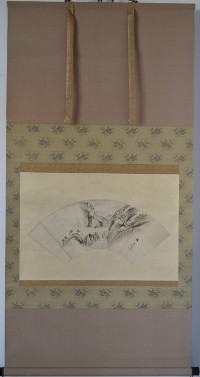
Click here to view image full size.
An original fan painting mounted as a scroll. Shows a gorge with the fast flowing Nagatoro River in Musashi Province. (An area in western Saitama Prefecture northwest of Tokyo.) Sumi and light blue on paper, 7 x 20.5 in; 17.75 x 52 cms. Comes with a certificate from Aoki Shinzaburo (who had a large collection of Hiroshige drawings and paintings). In good condition. Signed Hiroshige with Ryusai seal.
Status: Sold

Click here to view image full size.

Click here to view image full size.
Kikukawa EIZAN (1787-1867)
Click here to view image full size.
An original painting by Eizan who was the leading exponent of bijinga in the early 1800s producing many fine oban, triptych and shunga designs. He founded the Kikukawa School. Surprisingly, given his output of prints, his paintings are rare. This beautiful example, full colour on silk, 35 x 14.5 in; 88.9 x 36.8 cms, shows a courtesan reading a letter. Her sumptuous clothes are restrained in pattern and colour before the excesses of later years and other artists. Another example, not as fine as offered here, is in the Tokyo National Museum and is illustrated in their catalogue Ukiyo-e Painting Exhibition, 1993, no. 72, p. 64. The British Museum has a very slight painting of a beauty by Eizan illustrated in Ukiyo-e Paintings in the British Museum, Timothy Clark, Smithsonian Institution, 1992, no. 148, p. 195. One other fine example is illustrated in Masterpieces of ukiyo-e paintings from the Weston collection, various authors, 2015, no. 106, p. 161. Painted c. 1815-25. Signed Kikukawa Eizan hitsu with seals Kikukawa and Toshinobu. In very good condition having been recently remounted.
Status: Sold
Teisai HOKUBA (1771-1844)

Click here to view image full size.
One of the outstanding pupils of Hokusai, his paintings rated next below the master’s, and also one of the earliest, together with Hokkei and Shinsai. Designed some fine surimono, also kyoka books. But best known for his highly accomplished kakemono of bijin, often set against well known places in Edo. This pair of paintings shows, right, a beauty beneath a cherry tree, Sakura; and, left, a beauty on a small jetty beneath a maple tree, Momiji. Beautifully presented with old mounts and box. Full colour on silk. Image sizes 39.75 x 13.5 in; 101 x 34.5 cms. In extremely good condition with beautiful details on the costumes of the two bijin. Each painting signed Teisai with seals Tei Sai. Probably c 1830’s when his finest work is considered to have been made.
Status: Sold

Click here to view image full size.
Ichiryusai HIROSHIGE (1797-1858)
Click here to view image full size.
A newly discovered painting of a three-clawed Kano-style dragon amongst clouds. Although a subject popular with Japanese artists (and especially Chinese artists where the subject derives from), this appears to be the only such painting by Hiroshige extant. He did, however, produce two prints of the subject – a surimono and a large panel, both of around the same date. The signature indicates a date after 1840 and it was most likely painted for the Dragon Year 1844. Blue and brown ink on paper with extensive splashed ink. Image size 34.5 x 10.5 in; 87.7 x 26.7 cm. The mount uses a ryu-mon (dragon pattern) motif to match the subject. Very good condition. Signed Ichiryusai Hiroshige hitsu with Ichiryusai seal.
Status: Sold
Isoda KORYUSAI (FL c 1764-1788)
Click here to view image full size.
A superb original painting, full colour on silk, showing a beauty running in a late snowfall. Cherry blossom above. A leading artist of his time who produced some of the best bijin and kacho prints of the 1770s before concentrating on painting. Image size 40.25 x 14.25 in; 102.5 x 36 cm. Good condition. Painted c 1778. Signed Koryusai ga with seal Masakatsu, no in.
Status: Sold
Utagawa KUNINAO (1793-1854)
Click here to view image full size.
An original painting showing a sumptuously attired parading courtesan. Kuninao was a pupil of Toyokuni, then a follower of Hokusai. Above is a lengthy inscription on the Yoshiwara by Shikitei Sanba ( 1776-1822 ). Together with Santo Kyoden, a professional writer of gesaku fiction. Famous for one of the best known works of the late Edo period; Ukiyoburo or “Bathhouse of the Floating World” ( 1809 ). Full colour on silk, 33.25 x 12.25 in; 84.5 x 31 cms. Slight browning, otherwise good condition. Old mount in good condition. Painting signed Utagawa Kuninao with Utagawa seal. Inscription signed and sealed Shikitei Sanba with date Bunka 9 ( 1812 ).
Status: Sold
Ichiryusai HIROSHIGE (1797-1858)
Click here to view image full size.
Mitake from Kisokaido rokujukyu-tsugi no uchi, “Sixty-nine Stations of the Kisokaido.” The set of seventy prints was first published by Hoeido in 1835 with Eisen, but in 1837 Hiroshige took over and completed the series with the publisher Iseya Rihei (Kinjudo). The conjecture is that Hiroshige was the better known and more commercial artist, reinforced by the fact that Eisen’s name was removed from the designs already published. Hence, only the first editions have his signature on those prints. Shows a post station near to the famous Gankoji Temple. The inn and teahouse is advertising lodging.
Fine, very early impression. Fine colour and condition. Signed Hiroshige ga.
Status: Sold
Mori SOSEN (1747-1821)
Click here to view image full size.
A large original painting of one hundred monkeys. Sumi and light red on silk. Image size 57.5 x 32.25 in; 146 x 82 cms. The monkeys – some being white – are painted with great finesse and are shown perched on and scrambling over a large peach tree. Others are seated on rocky ledges around the tree in a mountainous landscape with a waterfall top left. Sosen is considered the best painter of monkeys in Japan, although he also depicted other animals. He is supposed to have lived for a while in the woods to better observe the monkeys. There are many copies of his work. Sosen produced several other one hundred monkey paintings and they are his masterpieces.
In very good condition. Signed Sosen utsusu with seal Morizo. A superb painting and extremely rare.
Status: Sold
Kochoro KUNISADA (1786-1865)
Click here to view image full size.
An original painted fan showing the actor Danjuro VIII. The fan has been used and dismounted from the frame and laid onto Japanese paper, hence the rib marks. Signed Toyokuni fude with red toshidama seal. Painted c 1858. Sold “as is.” Extremely rare.
Status: Sold

Click here to view image full size.
Kawanabe KYOSAI (1831-1889)
Click here to view image full size.
A fine painting showing Oishi Yoshio (Kuranosuke) with his fellow servants cavorting in a Bon-Odori dance behind him. The famous Chushingura story relates how Yoshio, the principle retainer and counsellor of Asano Takumi no Kami (Yenya), and his colleagues became ronin to avenge the death of their insulted master by eventually decapitating Kotsuke no Suke (Moronao). Kyosai shows Yoshio trying to mislead anyone who thinks they are planning such a revenge by holding a party. Full colour on silk. Image size 46 x 16 in; 116.8 x 40.7 cms. Exceptional condition. Signed Seisei Kyosai ga with seals Joku Kyosai and Kyosai. The former seal is on the fine painting showing Ushiwaka-maru playing the flute for Princess Joruri which is in the Kumamoto Prefectural Museum of Art and dated to c 1888.
Status: Sold
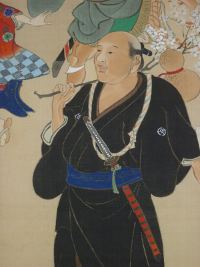
Click here to view image full size.

Click here to view image full size.

Click here to view image full size.
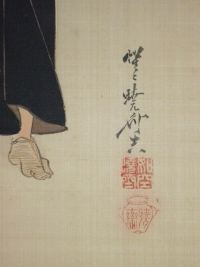
here to view image full size.
Tsukioka YOSHITOSHI (1839-1892)
Click here to view image full size.
An original painting showing what is probably the most famous encounter in Japanese mythology: The scene is evening on Gojo Bridge in Kyoto where the twenty year old Benkei ambushes samurai to steal their swords. He is shown approaching the flute-playing Yoshitsune. A fight ensues which Yoshitsune wins due to his leaping ability taught to him by the mountain tengu. Yoshitsune pardons Benkei and they become loyal friends. This painting, in shades of sumi, beautifully evokes the crepuscular gloom. On silk, 7 x 9.5 in; 17.75 x 24.1 cms. Painted c late 1870s. Signed Yoshitoshi with Taiso seal.
Status: Sold
Tsukioka SETTEI (1710-1786)
Click here to view image full size.
An interesting large painting, full colour on paper mounted on a wooden frame, 25.5 in; 62cms in diameter showing a bust portrait of a beauty with elaborate coiffure and a white mouse. Although not signed, the attribution is unquestionable, painted between 1767-1773 in Osaka. It appears to have been commissioned to hang in a hairdresser’s or cosmetic shop and has metal eyes at the top. The oxidised silver leaf background was meant to resemble a mirror and the idea of busts reflected in mirrors and silver grounds was later employed by Utamaro and Sharaku. Besides silver, gum and raised painting is applied. Such signboards appear in an illustrated book by Hasegawa Mitsunobu published in Osaka in 1752. This new discovery has been written about by Dr. Yamamoto Yukari in vol.27 of Minzoku Geijutsu (Ethno-Arts) in 2011. Minor surface marks all over but astonishingly good condition given their age and use. Extremely rare.
Status: Sold

Click here to view image full size.
Utagawa YOSHIHIDE (1832-1902)
Click here to view image full size.
A painting in full colour on silk, 33.75 x 14.4 in; 85.6 x 36.6 cms. Shows a beauty after a bath looking down at her mirror. Yoshihide was a pupil of Kuniyoshi. In extremely good condition. Signed and sealed Sesso. Inscription guarantee on inside of box: “Late February in the 56th Year of the Showa era (1981).” Appraised, signed and sealed by Mr Tosuke Kimura.
Status: Sold
Tsukioka SETTEI (1710-1786)
Click here to view image full size.
An interesting large painting, full colour on paper mounted on a wooden frame, 25.5 in; 62cms in diameter showing a bust portrait of a beauty with elaborate coiffure hanging paper acrobats. Although not signed, the attribution is unquestionable, painted between 1767-1773 in Osaka. It appears to have been commissioned to hang in a hairdresser’s or cosmetic shop and has metal eyes at the top. The oxidised silver leaf background was meant to resemble a mirror and the idea of busts reflected in mirrors and silver grounds was later employed by Utamaro and Sharaku. Besides silver, gum and raised painting is applied. Such signboards appear in an illustrated book by Hasegawa Mitsunobu published in Osaka in 1752. This new discovery has been written about by Dr. Yamamoto Yukari in vol.27 of Minzoku Geijutsu (Ethno-Arts) in 2011. Minor surface marks all over but astonishingly good condition given their age and use. Extremely rare.
Status: Sold

Click here to view image full size.
Ichiryusai HIROSHIGE ( 1797-1858 )
Click here to view image full size.
An original painting of the Sumida riverbank at Mimeguri, Toto ( Edo ). A full moon rises above a tori and is reflected in the river. Possibly originally from a makemono. Sumi and light colour on paper, 7.9 x 21.9 in; 20 x 55.5 cms. Sealed with a Ryusai seal used in his later years.
Status: Sold
Tsukioka SETTEI ( 1710-1786 )
Click here to view image full size.
An original painting showing a beauty sitting on an engawa having picked flowers which she is placing in a wooden bucket beside her. Settei produced many illustrated books but after around 1765 turned towards painting beauties, courtesans and geishas. They are of the utmost refinement – the faces and limbs picked out in red, their costumes often having areas of gold, and invariably have the wide lantern-locks ( toro-bin ) hairstyle. Settei also excelled at shunga painting. Sumi and full colour with details picked out in gold on silk. 30.75 x 11.5 in; 78.1 x 29.2 cms. Minor creasing but otherwise very good condition. An elaborately embroidered mount. Painted c 1770. Signed Tsukioka Settei with seals Shinten’o and Tsukioka shi.
Status: Sold
Tsukioka YOSHITOSHI ( 1839-1892 )
Click here to view image full size.
An original painting showing Fukurokugu – the God of Happiness, Wealth and Longevity and one of the Seven Gods of Good Luck, Shichi-fuku-ji, teasing a cat with the tassle on his fan. The Seven Gods theme comes from China, and possibly India as well, apart from Ebisu. Sumi on paper. Light creasing and rubbing at top otherwise good condition. Image size 47.75 x 22.5 in; 121.5 x 57 cms. Painted c 1880s.
Signed Yoshitoshi with seals Taiso Yoshitoshi.
Status: Sold
Katsushika HOKUSAI ( 1760-1849 )
Click here to view image full size.
Hotei with a karako puppet doll. Hotei, the God of abundance and good health, was one of the Seven Gods of Good Luck. The concept originated in India ( except Ebisu ) and came to Japan via China. He is usually shown as a shaven-headed priest in loose Chinese garments, holding a fan and reclining against a large bag. He is often surrounded by children trying to discover what is in the bag. Karako is a Chinese child who is usually depicted with a partly shaven head. These “treasures” were auspicious symbols of prosperity. Sumi and light colour on paper, image size 20.75 in x 13.5 in; 52.6 cms x 34.4 cms. The calligraphy is by Shotochinjin. Signed Gakyo Rojin Manji yowai hachi-go, “From the brush of Manji, old man mad with painting, aged eighty-five. With Katsushika seal. Exhibited in Masterpieces of Paintings by Hokusai School at the Itabashi Art Museum, 2008. . New mount and box with a futo-maki ( a thick wooden roll to preserve the painting from damage ). In fine condition.
Status: Sold
Kitagawa SHIKIMARO ( active c 1810 )
Click here to view image full size.
An original painting, full colour on silk, image size 37.75 in x 15 in; 96 cms x 38 cms.
This pupil of Kitagawa Tsukimaro is known for his prints of full length beauties. Paintings by him are extremely rare and this is possibly the finest example. Shows a Kagi-zu, a geisha who entertained by playing the shamisen. Her attendant is seen behind her holding the three-stringed instrument. The shamisen came originally from China via Okinawa and underwent certain changes. It was adopted by the geisha culture in 1750 and took a number of years to master. New mount and box with a futo-maki ( a thick wooden roll to preserve the painting from damage ). In fine condition. An exceptional painting – especially the rendering of the acolyte’s face. Signed Toto ( Eastern Capital ) Shikimaro ga with red kakihan.
Status: Sold
Ichiryusai HIROSHIGE (1797-1858)
Click here to view image full size.
A fine original Hiroshige painting showing ayu or ai, river trout, swimming in a stream or lake. The rocky bank overhangs and is reflected in the water. The ayu ( Plecoglossus altivelis ), or Japanese sweet fish, is synonymous with Gunma Prefecture. Although Hiroshige made other paintings of ayu, this is a rare subject. Also the subject of the best print from the first fish series published by Eijudo c 1832-4. Sumi and light colour on the ubiquitous grey silk Hiroshige liked to use, 15.25 x 21 in; 38.75 x 53.25 cms. Signed Hiroshige ga with Ichiryusai seal.
Status: Sold
Ichiryusai HIROSHIGE (1797-1858)
Click here to view image full size.
An important and fine original Hiroshige painting showing a view of Mount Fuji from Kisarazu in Chiba Prefecture. Minimalist and very subtle, this is one of the best Hiroshige paintings I have had. The near trees float above bands of mist and clouds hang at the base of Fuji. This is the same view that he used for the design Kazusa Kuroto no ura from the Thirty-Six Views of Fuji published 1858. There is also a drawing in a Hiroshige sketch book in the British Museum. Sumi and very light colour on paper, 49 x 17.75 in; 124.5 x 45 cms. Newly remounted and in fine condition. New box and futo-maki ( thick wooden roll to preserve the painting from damage ). Signed: Kamiusa Kurotonoura no zu Hiroshige ga with Ichiryusai seal.
Status: Sold
Katsushika HOKUGA (Fl. c 1820s to 1830)
Click here to view image full size.
An original fan painting showing a seated beauty holding a fan. Full colour on mica- covered paper. 6.5 x 18.5 in; 16.5 x 47 cms. Hokuga was a pupil of Hokusai and produced paintings and surimono. Good condition. Laid onto Japanese paper. Signed Hokuga hitsu.
Status: Sold
Katsukawa SHUNCHO (Fl. c 1780-1801)
Click here to view image full size.
An original painting showing a standing beauty inserting a hairpin. An important print artist who produced many fine diptychs and triptychs. Paintings by him are rare. Studied under Shunsho, then Kiyonaga and Shumman. Full colour on silk, 30.75 x 10.5 in; 78 x 26.5 cms. Signed Shien Shuncho with unread seals.
Status: Sold
Katsushika HOKUGA (Fl. c 1820s to 1830)
Click here to view image full size.
A fine original painting showing a beauty on the snow-covered dock used by boats to the Yoshiwara. Hokuga was a pupil of Hokusai and produced paintings and surimono. Full colour on silk, 37.5 x 11.25 in; 92.75 x 28.5 cms. Two repaired wormholes, otherwise very good condition. Box with title “Beauty Standing on Dock” with painting guaranteed on the underside of lid by Narasaki Muneshige. Illustrated in Ukiyo-e Paintings in Japanese Collections, vol. 7: the Manno Art Museum, edited by Kobayashi Tadashi. The inscription above is by Ota Nampo – Shokusanjin ( 1749-1823 ). Signed Karyosai Hokuga fude.
Status: Sold
Gessai GABIMARU (Fl. c 1810)
Click here to view image full size.
A beautiful painting of a parading courtesan. A follower of Chobunsai Eishi in the Bunka period. There are works by him signed Chobunsai, so he may have been related to Eishi. Full colour on silk, 29.5 x 5.75 in; 75 x 14.5 cms. Painting in good condition. Mount is old and the painting should either be framed or remounted. Signed Gessai Gabimaru ga.
Status: Sold
Shiokawa BUNRIN et al
Click here to view image full size.
A fine Kyoto gassaku painting. ( A collaborative work by a group of friends. ) Shows a lobster by Shiokawa Bunrin ( 1808-1877 ), a pupil of Toyohiko; clams by Hasegawa Gyokuho ( 1822-1879 ) a pupil of Keibun; a sea bream by Yokoyama Seiki ( 1792-1864 ) a pupil of Keibun; and a stingray by Murase Soseki ( 1822-1877 ), a pupil of Keibun and Seiki. Four masters of the Shijo school. A large painting in full colour on silk in very good condition, 52.5 x 27.5 in; 133.5 x 70 cms. Mount in very good condition.
Status: Sold
Ichiryusai HIROSHIGE (1797-1858)
Click here to view image full size.
A large and important painting showing a view of the Sumida River through the piles of the Ryogoku Bridge. In the distance the ofunagura, “boat houses,” boats on the river and the Shogun’s official horses – goyouba – being taken out by samurai to the shoal outside the ofunagura-mae, the Shogun’s dock, to be cooled off. This masterpiece appears to be from a series of views of the Sumida as there is another – a view of Mimeguri, Sumida river bank in snow – in the Bato Hiroshige Museum of Art. The size, signature and seal is the same. Sumi and light colour on paper, 21.25 in; 54 cms. x 37 in; 94 cms. In very good condition. Old mount and box. Signed Hiroshige ga with Ichiryusai seal.
Status: Sold
Kono BAIREI (1844-1895)
Click here to view image full size.
A fine painter of kacho-ga and landscapes. Born and lived in Kyoto. Studied under Raisho and Bunrin. Especially well known for his teaching: In 1878 he began to work towards the establishment of an art school that opened in 1880 as the Kyoto Prefectural School of Painting. Contributed to numerous books from Bairei hyakucho gafu, 1881 to Bairei kacho gafu, 1881, Bairei hyakucho gafu zoku hen, 1884, Bairei gafu, 1886 et al. Shows a shoal of red sea bream, Pagrus major, and an octopus. Full colour on silk, 42.75 in; 108.5 cms. x 14 in; 35.5 cms. Probably original mount. Several small insect marks, otherwise very good condition. Signed Bairei with seals Naotoyo and Bairei.
Status: Sold









